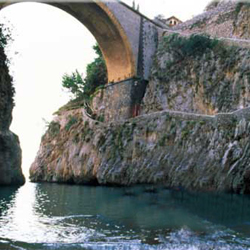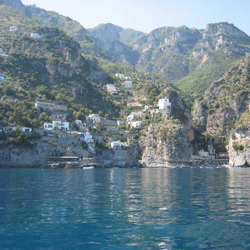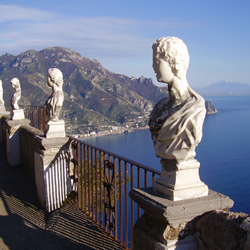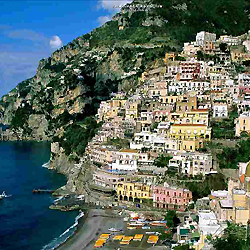Campania Tours
Pompei, Positano and Sorrento | Amalfi Coast and Ravello | Capri Island
Amalfi Coast and Ravello
The Amalfi Coast has become famous throughout the world for the unique beauty of its landscapes. The twisting road squeezed between the rocks reveals tantalising glimpses of small villages, secluded bays, and inlets, all looking out over a clear blue sea in stark contrast to the lush green Mediterranean flora which colours the slopes of the hills and cliffs. A journey which leads the traveller not only to towns of world wide fame such as the picturesque Positano, the one time Marine Republic of Amalfi, and the superbly elegant Ravello, but also to lesser known, yet exquisitely beautiful, places such as Nerano, La Marina di Furore, Conca dei Marini, and Praiano. Continuing further along the coastal route one comes upon a series of fascinating towns facing the Gulf of Salerno - Maiori, Minori, Vietri sul Mare, Salerno, and Paestum. The fascinating Amalfi Coast and Gulf of Salerno form part of a territory which unites various Mediterranean cultures and where the local traditions are steeped in an ancient past. This is a land where nature and history embrace to create a magical atmosphere, where peace reigns supreme over the shimmering sea, and visitors are left quite simply spellbound.
Suggested full day tour from Rome with the visit of Nerano, La Marina di Furore, Conca dei Marini, Praiano, Amalfi and Ravello, the service is driver/guided and is individually personalized.
Pompei, Positano and Sorrento | Amalfi Coast and Ravello | Capri Island
Amalfi Coast and Ravello
The Amalfi Coast has become famous throughout the world for the unique beauty of its landscapes. The twisting road squeezed between the rocks reveals tantalising glimpses of small villages, secluded bays, and inlets, all looking out over a clear blue sea in stark contrast to the lush green Mediterranean flora which colours the slopes of the hills and cliffs. A journey which leads the traveller not only to towns of world wide fame such as the picturesque Positano, the one time Marine Republic of Amalfi, and the superbly elegant Ravello, but also to lesser known, yet exquisitely beautiful, places such as Nerano, La Marina di Furore, Conca dei Marini, and Praiano. Continuing further along the coastal route one comes upon a series of fascinating towns facing the Gulf of Salerno - Maiori, Minori, Vietri sul Mare, Salerno, and Paestum. The fascinating Amalfi Coast and Gulf of Salerno form part of a territory which unites various Mediterranean cultures and where the local traditions are steeped in an ancient past. This is a land where nature and history embrace to create a magical atmosphere, where peace reigns supreme over the shimmering sea, and visitors are left quite simply spellbound.
Suggested full day tour from Rome with the visit of Nerano, La Marina di Furore, Conca dei Marini, Praiano, Amalfi and Ravello, the service is driver/guided and is individually personalized.
| Furore. Those traveling on the road along the Amalfi Coast will not be able to appreciate the beauty of Furore unless they deliberately go there. Hidden away in the mountains, Furore is particularly striking because of its unique urban structure. The town is completely bereft of squares and open spaces, and is a maze of alleyways and flights of steps which clings to the hillside. Furore was built on terraces carved into the rock face. The town is divided into an internal part, where the village can be found, and a crevasse, which plummets into the sea known, as the "Fiord of Furore". The village is known as a small center of popular culture, characterized by legends and linguistic inventions ("nicknames"), and for being chosen as the set for films such as "Il Miracolo", "Paisà", "La Macchina Ammazzacattivi", and "Viaggio in Italia". These films brought personalities such as Federico Fellini, Roberto Rossellini and Anna Magnani to Furore. It is a town which lives among the memories of the past and a love for cinema, within a landscape which is itself a natural film set. |
 |
| Praiano. The Amalfi Coast is a part of the world well worth exploring. In addition to its well known sea resorts, there are a whole host of tiny settlements which still maintain truly ancient artistic and popular traditions. Praiano is one of these small towns, a fishing village immersed in a peaceful landscape, once the resort chosen by the Doge in past centuries.Traditional crafts still flourish in Praiano, from the production of silk garments to the embroidered pieces worked by the women of the village. Praiano is situated between Monte St Angelo a Tre Pizzi and Capo Sottile, a tiny area of land characterized by its dramatic scenery. To visit: the parish Church of St Luca Evangelista, which houses works of art from the 1500's by Bernardo Lama, a relic of the Saint and a silver bust dating back to 1694. Next to the church one finds the three tiered bell tower which overlooks the entire village. |
 |
| Ravello. Between the Valley del Dragone and the Valley della Regina, up a supremely panoramic narrow road, which twists up from the coast towards the mountains, one finds Ravello. Its dominating position on the hill top offers the tourist a spectacular view over the whole of the Amalfi Coast. The tranquility of the town greatly appealed to poets and writers and international jet set. The wealth of art works in Ravello is preserved in numerous ecclesiastical buildings such as the Cathedral of St Pantaleone, Patron saint of the town, a building which is striking because of its marble work; the adjacent bell tower, the Church of St Martino, the Church of St Angelo and the Church of St Giovanni del Toro.The heart of Ravello is the Piazza Vescovado, with the Castle ruins, the Cathedral and Palazzo Rufolo. Villa Rufolo should not be missed, a building which is home to much of the art of Ravello and surrounded by splendid gardens, where numerous musical and cultural events are held. Villa Cimbrone is also well worth a visit. |
 |
| Amalfi. Legend has it that Hercules fell in love with a nymph called Amalfi, a love which was cruelly ended by her death. The nymph was then buried in this, the most beautiful place in the world, and the city which was built here was named after her. It is not by chance that Amalfi, an ancient maritime Republic, is the heart of this stretch of coast, the famous Amalfi Coast, an International tourist destination, attracting those lured by its uniquely colored sea. The town hosts many traditional celebrations and events, including the descent of the comet from Monte Tabor, the Festa of St. Giuseppe, the Festa of St.Antonio, the historic sailing regatta contested by the four maritime republics, the lemon fair, St.Andrea patron saint of Amalfi, the underwater procession to the Grotta dello Smeraldo held at Christmas, the firework display of New Year's Eve and the traditional Via Crucis. To see: the Church of St Antonio, the Convent of St Francesco, the Paper Museum, the Chapel of St. Giuseppe del Castrista and the sumptuous Amalfi Cathedral. The most important of the town's craft traditions is that of paper making, which began in the 1700's. |
 |